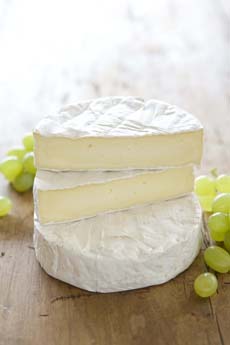TIP OF THE DAY: Eat The Bloomy Rind

Eat the rind! Photo of Brie courtesy Whole Foods Markets. |
White rinds on cheese—called bloomy rinds—are meant to be eaten. If you’ve been cutting them away, try them. Connoisseurs consider the rind part of the unique character of the cheese.
The bloomy rind category of cheese refers to those cheeses with snowy white, downy rinds and soft, creamy interiors. Along with fresh cheeses, it comprises the soft cheese category. On a bloomy rind cheese, the rind is composed of one of the greatest cheese molds, Penicillium candidum, which grows naturally as the cheese ages (the antibiotic penicillin is derived from the same family of mold—it was discovered by accident by Sir Alexander Fleming, who found that a penicillium mold growing in a petri dish had killed the Staphylococcus in the dish). The bloomy rind is produced by spraying the surface of the cheese with Penicillium candidum before the brief aging period (about two weeks). The mold grows on the outside of the cheese, breaking down the protein and fat inside, making it soft, runny and more complex.
|
|
| The rinds of all cheeses are edible, but some are best left to other purposes. These include hard rinds of aged cheeses (which can be used to flavor soups and stews) and bandaged-wrapped cheeses: You don’t want to eat the cloth!
|
||


